If you’ve started learning barre chords on guitar, you might have found them to be much tougher to play than you expected. Learning these chords can be a frustrating and uncomfortable process but there are ways approach them more ease which we’ll look at.
After you learn your open chords on guitar, which are the ones you usually play in the first couple of frets, you might also want be able to play in other parts of the fretboard. This is where learning barre chords will help you to expand your playing to the next level.
In this lesson, we’ll cover how to play barre chords on guitar, examples to apply them over common chords, and 5 tips to get better at playing them. Grab your guitar and let’s get started!
What is a barre chord?
Barre chords are chords that require you to cover multiple strings with one of your fingers. These chords have movable shapes that help you shift chords throughout the guitar and are especially useful when you have chords that include sharp or flat notes which can’t be played using open strings on the guitar.
The finger that covers multiple strings is essentially acting as a capo, a tool used to clamp down on the guitar for shifting chords. As a side note, I personally recommend learning barre chords so that you don’t ever have to rely on using a capo.
That being said, let’s go over the guitar chord charts to learn how to play barre chords starting on different strings.
Barre chord shapes on guitar on the 6th string
I’ll first show you what barre chord shapes look like starting on different strings and then go over some tips to approach these chords. Once you learn the following chord shapes, you can simply shift them to start on different root notes.
For each chord shape, the chord tones are written to the right of each string.
You can see how the 1st finger is covering all 6 strings at a the same time in the charts below.
Major barre chord on the 6th string
This shape is essentially coming from the open E Major chord shape but we add the barre to shift to any Major chord. For example, you can play a G Major chord by starting this shape on the 3rd fret or a Bb chord on the 6th fret.
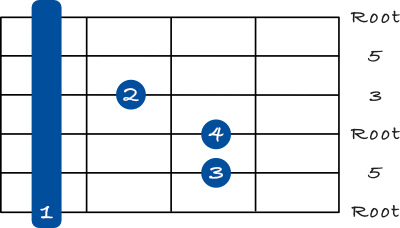
Minor barre chord on the 6th string
The minor barre chord on the 6th string is coming from the open E minor chord shape. We are simply removing finger 2 (middle finger) from the previous shape.
To give you some application examples, you can play an Ab minor chord by starting this shape on the 4th fret or a B minor chord on the 7th fret.

Barre chord shapes on guitar on the 5th string
For the following charts, your first finger is covering the 1st 5 strings.
Major barre chord on the 5th string
The Major barre chord on the 5th string is coming the open A Major chord shape. Again, we have to add the barre with the 1st finger to shift to any chord on the same string. For example, you can play a Db Major chord by starting this shape on the 4th fret or an F Major chord on the 8th fret.
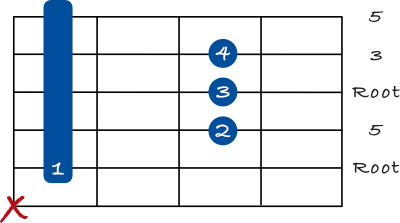
Minor barre chord on the 5th string
The minor barre chord on the 5th string is coming from the open A minor chord shape. We have to rearrange fingers 2, 3, and 4 from the previous shape.
To give you some application examples, you can play an B minor chord by starting this shape on the 2nd fret or an F minor chord on the 8th fret.
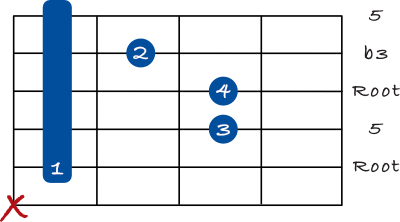
I only included these Major and minor chord shapes on the 6th and 5th string because they are the most common and useful shapes that I recommend learning first. To learn 7th chords that use barre chords, check out this lesson on how to play the essential 7th chords on guitar.
Like I mentioned earlier, these are all movable shapes that can be shifted to any root note. All you need to do is find the root note, meaning the lowest note of the chord and then add the Major or minor shape accordingly.
Shifting barre chords example
As you may already know, barre chords make it easy to play any chord by shifting a shape. For example, if you want to play Ab (A flat) Major, just move the Major shape one fret to the left like this:

Barre chord examples for common chords
Here are examples of barre chord shapes for different Major and minor chords on the 6th and 5th strings.
C Major barre chords

C minor barre chords

D Major barre chords
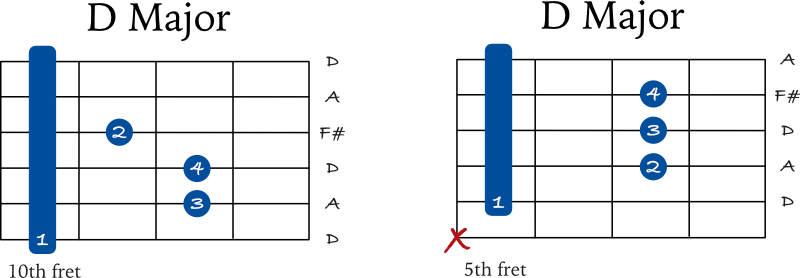
D minor barre chords

E Major barre chords
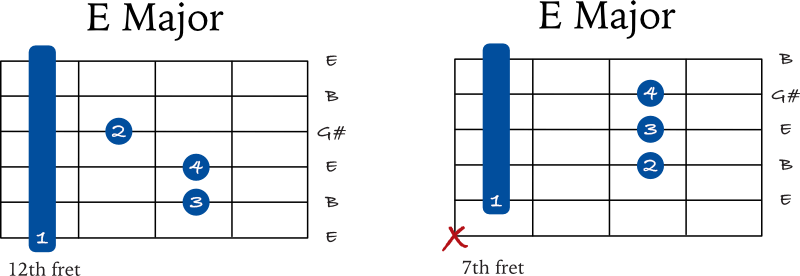
E minor barre chords
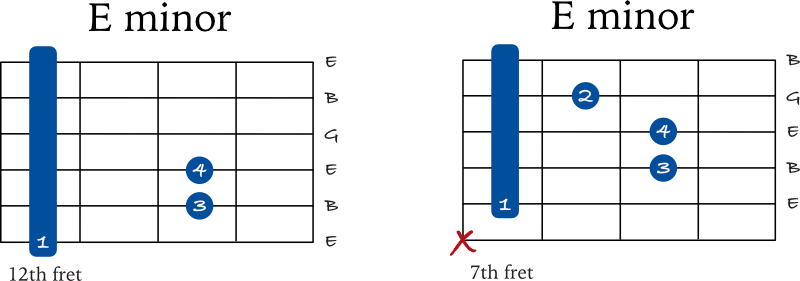
F Major barre chords
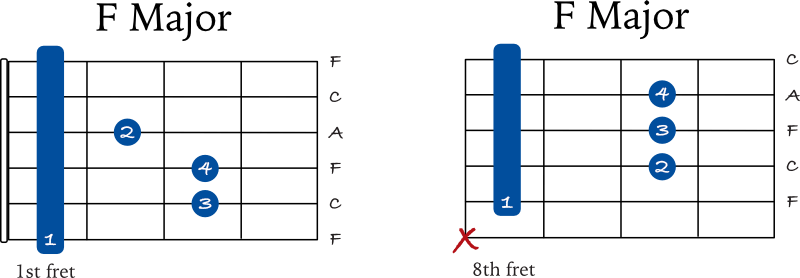
F minor barre chords
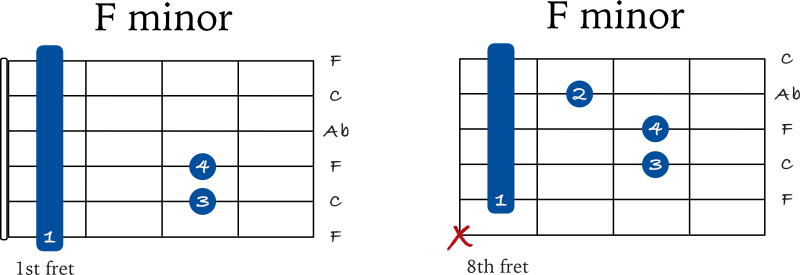
G Major barre chords

G minor barre chords
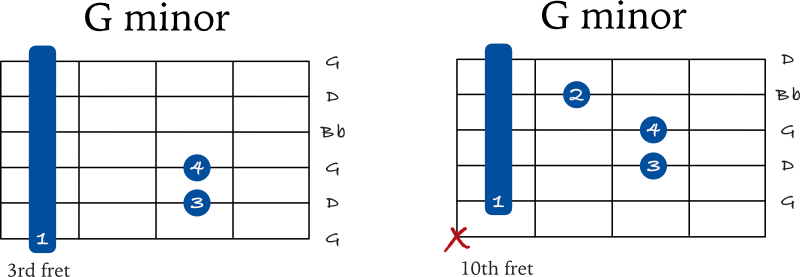
A Major barre chords
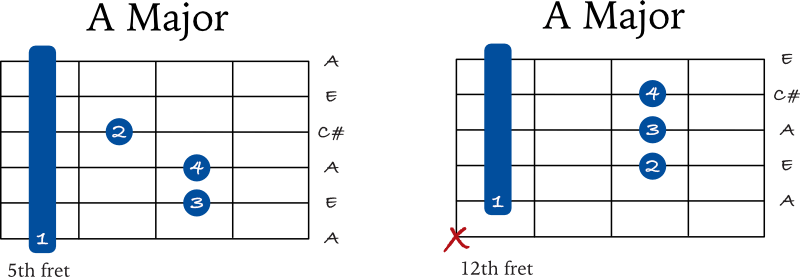
A minor barre chords

B Major barre chords

B minor barre chords
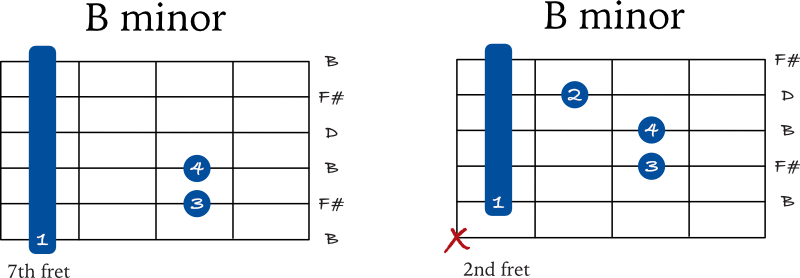
Barre chords are an effective tool to play chords throughout the fretboard but it may take some time to get these chords to sound clear at first. Here are some tips to help you get better at playing barre chords below.

5 tips get better at playing barre chords on guitar
Tip 1: Master power chord shapes first
A power chord is a simplified chord that has 2 or 3 notes and can often be substituted for Major and minor chords. You can recognize these chords whenever you see a ‘5’ next to the root note of a chord, such as C5 or G5.
These power chords are characterized by the following shapes which are simply shifted to the root note accordingly.
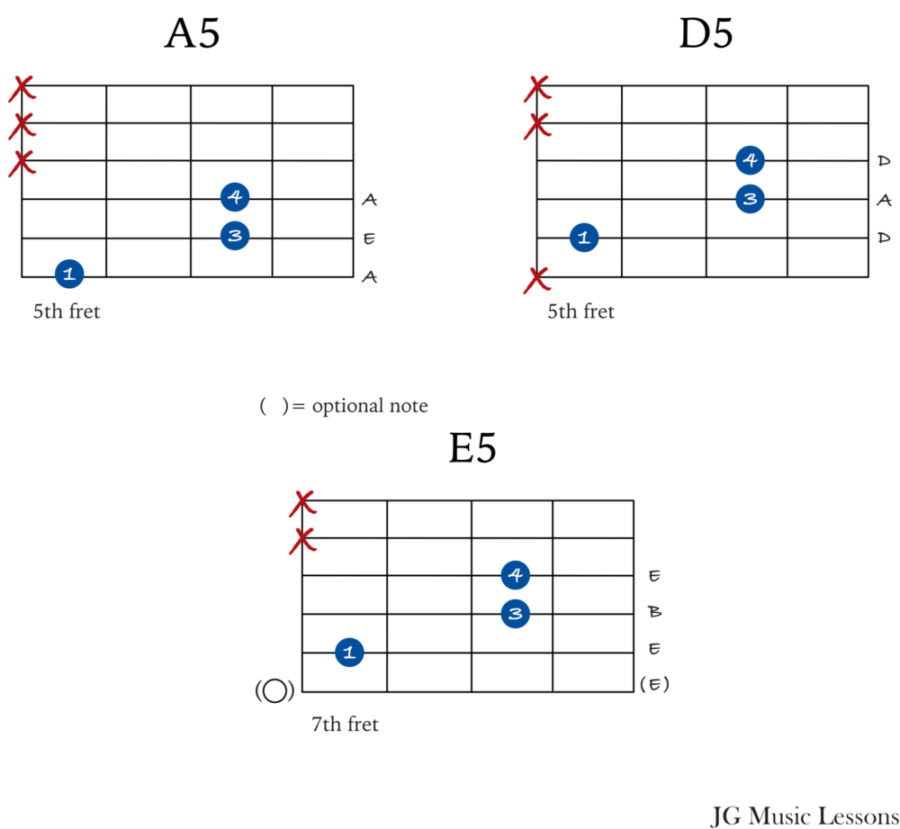
Since these power chords form the majority of the barre chord shapes and no fret has to be barred yet, knowing these are a great place to start.
Tip 2: Add extra fingers above the power chord shape
Once you have your power chords down, you can simply add one more finger to play the Major shape on the 6th string and the minor shape on the 5th string.
You can start trying to barre these chords, but if it’s not sounding clear, the goal is to at least play the first four notes of the chord (starting from the lowest note and above).
Next, I would try the 6th string minor shape which is a bit harder because it requires you to actually barre the 4th note from the lowest note.
Lastly, try the 5th string Major shape since you will need to readjust the 2nd, 3rd and 4th finger differently from the other barre chord shapes.
Tip 3: Play the main notes of the chord until you can barre every string
Like I mentioned before, the main thing is to get at least four notes starting from the root note for you to be able to start using these chords. The first four notes of a barre chord are enough to differentiate the chord quality, meaning a Major or minor chord. Even if you’re missing the highest note on top, they can still sound good until you can play the whole chord.
Tip: Use your thumb behind the fretboard to help you have more stable and secure grip when playing barre chords.
Tip 4: Try the chord shapes higher up on the fretboard for less string tension
If your still having a hard time play a certain chord shape, try playing the same shape higher up in the fretboard, say 9th fret or higher. This is because there is less tension on the string the higher you go up, which makes it much easier to press down the whole chord.
You can apply this to any barre chord whenever you are having a hard time pressing down the whole chord. Trying to play these shapes closer to the 1st fret can be very difficult at first so simply start higher and gradually move the chord to the left as you develop more strength in your hand and fingers.
The more you practice these chords, you also develop muscle memory which makes them easier to play over time.
Tip 5: Play one note a time to see which strings need adjustment
At this point, you are trying to get more clarity with these chords and have to make some adjustments if you hear any buzzy or muted notes. A helpful tip to resolve any sound issues is to play one string at a time while pressing down your barre chord to identify what strings need to be corrected.
If some notes are still sounding muted, try rolling your 1st finger slightly to the left to be able to press down harder on the fretboard. Also, check if any finger is touching a string that shouldn’t be.
If you are still having problems, you can also try to barre the strings with your 1st finger before you add the other fingers and see if that helps you to play the chord more clearly.
Wrapping up
Barre chords are a great tool to have under your musical tool belt because they open doors of chord possibilities and give you the ability to play anywhere on the fretboard. Give yourself some to learn and recap these chords in your practice time and before you know it, you’ll be able to incorporate them in songs.
Learning barre chords will open up new possibilities on the guitar to play more songs and be able to shift them to different keys. Plus, you won’t ever have to rely on a capo to play any song!
To review, the 5 tips for getting better at barre chords are:
- Master power chord shapes first
- Add extra fingers above the power chord shape
- Play the main notes of the chord until you can barre every string
- Try the same chord shape higher up on the fretboard (there is less string tension)
- Play one note a time to see which strings need adjustment
Once you’re feeling confident about playing barre chords, I would look into learning your 7th chords which use similar shapes.
📘 Get the free guitar practice guide here!
All the best,
JG Music Lessons
Start Playing Better, Faster
with Pro Membership! ✨
Get the guidance, tools, and support that keep your progress on track:
🏁 Always know what to practice next. Access the full Guitar Learning Roadmap with lessons in sequence.
🎼 Play songs with confidence. Step-by-step lessons of popular, classical pieces and other styles.
📙 Save time and frustration. Clear PDFs and ebooks that save time so you can focus on playing.
🎟️ Get rewarded for consistency. 2 free downloads every month (a $240+ yearly value).
🎁 Keep costs low while you grow. 50% off all charts, tracks, and posters — up to 75% off bundles.
🚫 Stay focused. Ad-free environment keeps you in the zone.
💬 Get help when you need it. Direct member support to keep you on track.

